Sustainability Performance through Technology Adoption: A Case Study of Land Leveling in a Paddy Field
Abstract
1. Introduction
2. Materials and Methods
2.1. Environment
2.2. Land-Leveling Procedures
2.3. Material Flow Diagram and Energy Analysis
2.4. Economic Analysis
3. Results and Discussion
4. Conclusions
Author Contributions
Funding
Acknowledgments
Conflicts of Interest
References
- Jat, M.L.; Gupta, R.; Ramasundaram, P.; Gathala, M.; Sidhu, H.S.; Singh, S.; Singh, R.; Saharawat, Y.; Kumar, V.; Chandna, P.; et al. Laser-assisted precision LL: A potential technology for resource conservation in irrigated intensive production systems of Indo-Gangetic Plains. In Integrated Crop and Resource Management in the Paddy-Wheat System of South Asia; Ladha, J.K., Singh, Y., Eds.; International Rice Research Institute (IRRI): Los Bolaños, Philippines, 2009; pp. 223–237. [Google Scholar]
- Khan, F.; Khan, S.U.; Sarir, M.S.; Khattak, R.A. Effect of LL on some physico-chemical properties of soil in district DIR lower. Sarhad J. Agric. 2007, 23, 107–114. [Google Scholar]
- Bouman, B.A.M.; Hengsdijk, H.; Hardy, B.; Bindraban, P.; Tuong, P.; Ladha, J.K. Water-Wise Paddy Production; International Rice Research Institute (IRRI): Los Bolaños, Philippines, 2002; 356p. [Google Scholar]
- Chauhan, B.S. Weed Management in Direct-Seeded Rice Systems; International Rice Research Institute (IRRI): Los Bolaños, Philippines, 2012; 20p. [Google Scholar]
- Bueno, M.V.; de Campos, A.D.S.; da Silva, J.T.; Massey, J.; Timm, L.C.; Faria, L.C.; Roel, A.; Parafit, J.M.B. Improving the Drainage and Irrigation Efficiency of Lowland Soils: Land-Forming Options for Southern Brazil. J. Irrig. Drain Eng. 2020, 146, 04020019. [Google Scholar] [CrossRef]
- Quiros, J.J.; Aguero, J.A.; Fiorio, P.R. Melhoramento da drenagem através da técnica de nivelamento por declividade variável em uma área de algodão com o sistema GNSS-RTK_AGForm-3D. In Proceedings of the XLIV Brazilian Congress of Agricultural Engineering, Sao Pedro-SP, Brazil, 13–17 September 2015. [Google Scholar]
- Quiros, J.; Winkler, A.S.; Aguero, J.; Tavares, T.R.; Martello, M. Efeito da sistematização por declividade variável no microrrelevo de talhão cultivado com arroz no pacífico central da Costa Rica. In Proceedings of the Brazilian Congress of Precision Agriculture, Goiânia, Brasil, 4–6 October 2016. [Google Scholar]
- Quiros, J.; Winkler, A.; Aguero, J. Avaliação do desempenho da marcação de taipas com um sistema de direção automática assistida. In Proceedings of the X Brazilian Congress of Irrigated Rice, Gramado-RS, Brazil, 8–11 August 2017. [Google Scholar]
- Sowell, R.S.; Shih, S.F.; Kriz, G.J. Land forming design by linear programming. Trans. ASABE 1973, 16, 296–301. [Google Scholar] [CrossRef]
- Aquino, L.S.; Timm, L.C.; Reichardt, K.; Barbosa, E.P.; Parfitt, J.M.B.; Nebel, A.L.C.; Penning, L.H. State-space approach to evaluate effects of land levelling on the spatial relationships of soil properties of a lowland area. Soil Till. Res. 2015, 145, 135–147. [Google Scholar] [CrossRef]
- Perryman, M.E.; Schramski, J.R. Evaluating the relationship between natural resource management and agriculture using embodied energy and eco-exergy analyses: A comparative study of nine countries. Ecol. Complex. 2015, 22, 152–161. [Google Scholar] [CrossRef]
- Bora, G.C.; Nowatzki, J.F.; Roberts, D.C. Energy savings by adopting precision agriculture in rural USA. Energy Sustain. Soc. 2012, 2, 5. [Google Scholar] [CrossRef]
- Brown, M.T. A picture is worth a thousand words: Energy systems language and simulation. Ecol. Model. 2004, 178, 83–100. [Google Scholar] [CrossRef]
- Romanelli, T.L.; Milan, M. Material flow determination through agricultural machinery management. Sci. Agric. 2010, 67, 375–383. [Google Scholar] [CrossRef]
- Spekken, M.; de Bruin, S. Optimized routing on agricultural fields by minimizing maneuvering and servicing time. Precis. Agric. 2013, 14, 224–244. [Google Scholar] [CrossRef]
- Spekken, M.; Molin, J.P.; Romanelli, T.L. Cost of boundary manoeuvres in sugarcane production. Biosyst. Eng. 2015, 129, 112–126. [Google Scholar] [CrossRef]
- Colaço, A.F.; Povh, F.P.; Molin, J.P.; Romanelli, T.L. Energy assessment for variable rate nitrogen application. Agric. Eng. Int. CIGR J. 2012, 14, 85–89. [Google Scholar]
- Monge, L.A.; Alvardo, A. Caracterización y clasificación de los principales suelos del Valle de Parrita. Argon. Costarr. 1979, 3, 123–128. [Google Scholar]
- Topcon Agriculture. Available online: https://www.topconpositioning.com/agriculture (accessed on 8 July 2020).
- Odum, H.T. Environmental Accounting: Emergy and Environmental Decision Making, 1st ed.; Wiley: Hoboken, NJ, USA, 1996; p. 359. [Google Scholar]
- Eskandari, H.; Attar, S. Energy comparison of two paddy cultivation systems. Renew. Sustain. Energy Rev. 2015, 42, 666–671. [Google Scholar] [CrossRef]
- Rathke, G.W.; Wienhold, B.J.; Wilhelm, W.W.; Diepenbrock, W. Tillage and rotation effect on corn-soybean energy balances in eastern Nebraska. Soil Till. Res. 2007, 97, 60–70. [Google Scholar] [CrossRef]
- Pellizzi, G. Use of energy and labour in Italian agriculture. J. Agric. Eng. Res. 1992, 52, 111–119. [Google Scholar] [CrossRef]
- AgLeader. Available online: https://www.agleader.com (accessed on 8 July 2020).
- Atlason, R.; Unnthorsson, R. Ideal EROI (energy return on investment) deepens the understanding of energy systems. Energy 2014, 67, 241–245. [Google Scholar] [CrossRef]
- Brar, A.S.; Buttar, G.S.; Jhanji, D.; Sharma, N.; Vashist, K.K.; Mahal, S.S.; Deol, J.S.; Singh, G. Water productivity, energy and economic analysis of transplanting methods with different irrigation regimes in Basmati paddy (Oryza sativa L.) under north-western India. Agric. Water Manag. 2015, 158, 189–195. [Google Scholar] [CrossRef]
- Valentas, K.; Singh, R.P.; Rotstein, E. Handbook of Food Engineering Practice; CRC Press: Boca Raton, FL, USA, 1997. [Google Scholar] [CrossRef]
- Corporación Arrocera Nacional (CONARROZ). Statistical Report, 2011–2012. 2012. Available online: https://www.conarroz.com/estadisticasarroceras.php (accessed on 8 July 2020).
- Corporación Arrocera Nacional (CONARROZ). Statistical Report, 2012–2013. 2013. Available online: https://www.conarroz.com/estadisticasarroceras.php (accessed on 8 July 2020).
- Corporación Arrocera Nacional (CONARROZ). Statistical Report, 2013–2014. 2014. Available online: https://www.conarroz.com/estadisticasarroceras.php (accessed on 8 July 2020).
- Corporación Arrocera Nacional (CONARROZ). Statistical Report, 2012–2015. 2015. Available online: https://www.conarroz.com/estadisticasarroceras.php (accessed on 8 July 2020).
- National Oceanic and Atmospheric Administration (NOAA). Cold & Warm Episodes by Season. Available online: https://origin.cpc.ncep.noaa.gov/products/analysis_monitoring/ensostuff/ONI_v5.php (accessed on 19 August 2020).
- Quiros, J.; Winkler, A.S.; Aguero, J.; Tavares, T.R.; Martello, M. Efeito da sistematização sobre a produtividade e distribuição de unidades de gestão diferenciada em um campo cultivado com arroz (Oriza sativa). In Proceedings of the Brazilian Congress of Precision Agriculture, Goiânia, Brasil, 4–6 October 2016. [Google Scholar]
- National Meteorological Institute of Costa Rica (IMN). Boletín ENOS. Available online: https://www.imn.ac.cr/boletin-enos (accessed on 19 August 2020).
- Khoshnevisan, B.; Rajaeifar, M.A.; Clark, S.; Shamahirband, S.; Anuar, N.B.; Shuib, N.L.M.; Gani, A. Evaluation of traditional and consolidated paddy farms in Guilan Province, Iran, using life cycle assessment and fuzzy modeling. Sci. Total. Environ. 2014, 481, 242–251. [Google Scholar] [CrossRef] [PubMed]
- Food and Agriculture Organization (FAO). Water Scarcity—One of the Greatest Challenges of Our Time. Available online: http://www.fao.org/fao-stories/article/en/c/1185405/ (accessed on 18 August 2020).
- Food and Agriculture Organization (FAO). Resources and Challenges in the Context of Climate Change. Available online: http://www.fao.org/3/i2345e/i2345e04.pdf (accessed on 18 August 2020).
- Abdullaev, I.; Hassan, M.U.; Jumaboev, K. Water saving and economic impacts of LL: The case study of cotton production in Tajikistan. Irrig. Drain. Syst. 2007, 21, 251–263. [Google Scholar] [CrossRef]
- Borrelli, P.; Robinson, D.A.; Fleischer, L.R.; Lugato, E.; Ballabio, C.; Alewell, C.; Meusburger, K.; Modugno, S.; Schütt, B.; Ferro, V.; et al. An assessment of the global impact of 21st century land use change on soil erosion. Nat. Commun. 2017, 8, 1–13. [Google Scholar] [CrossRef] [PubMed]
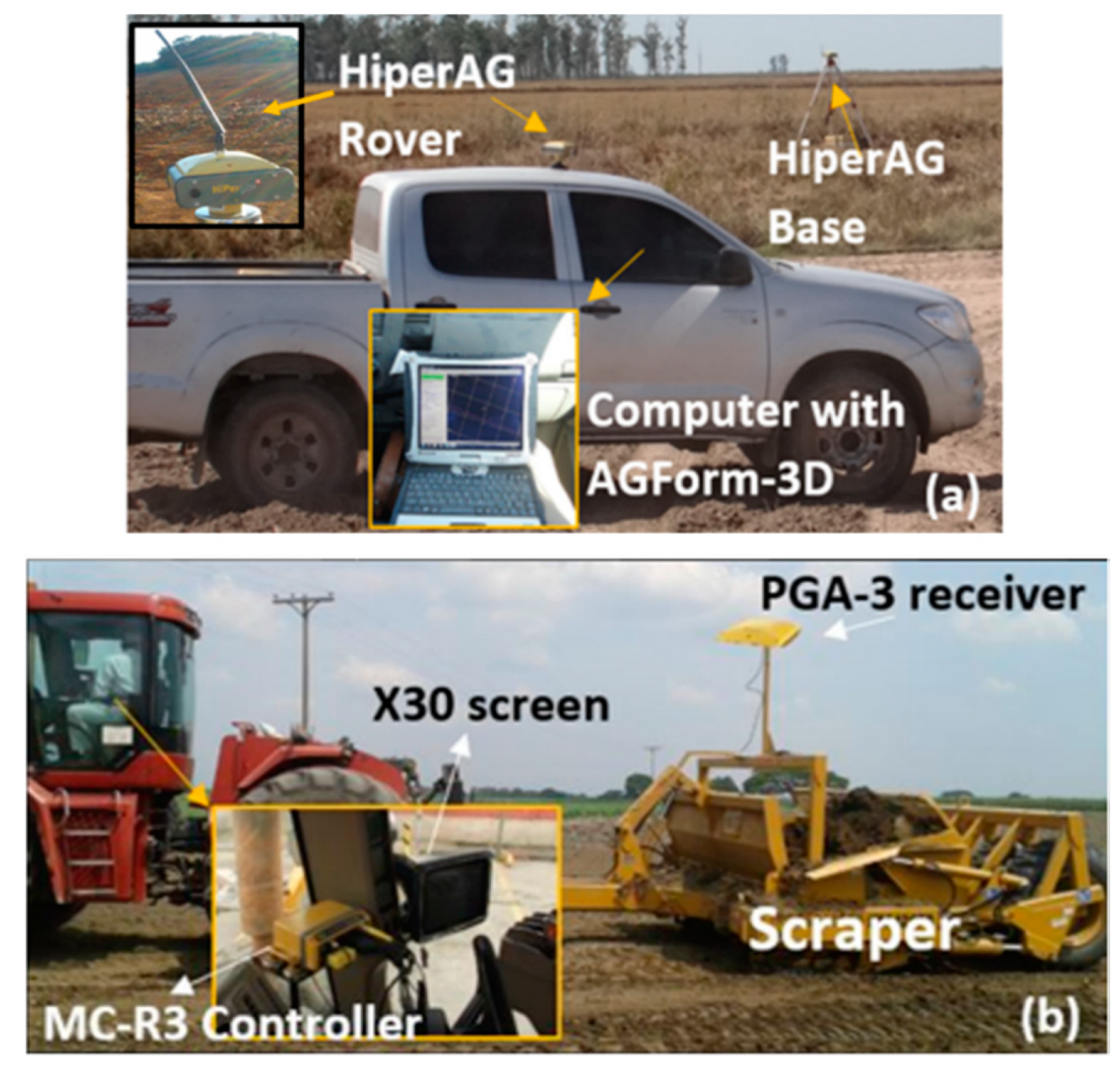
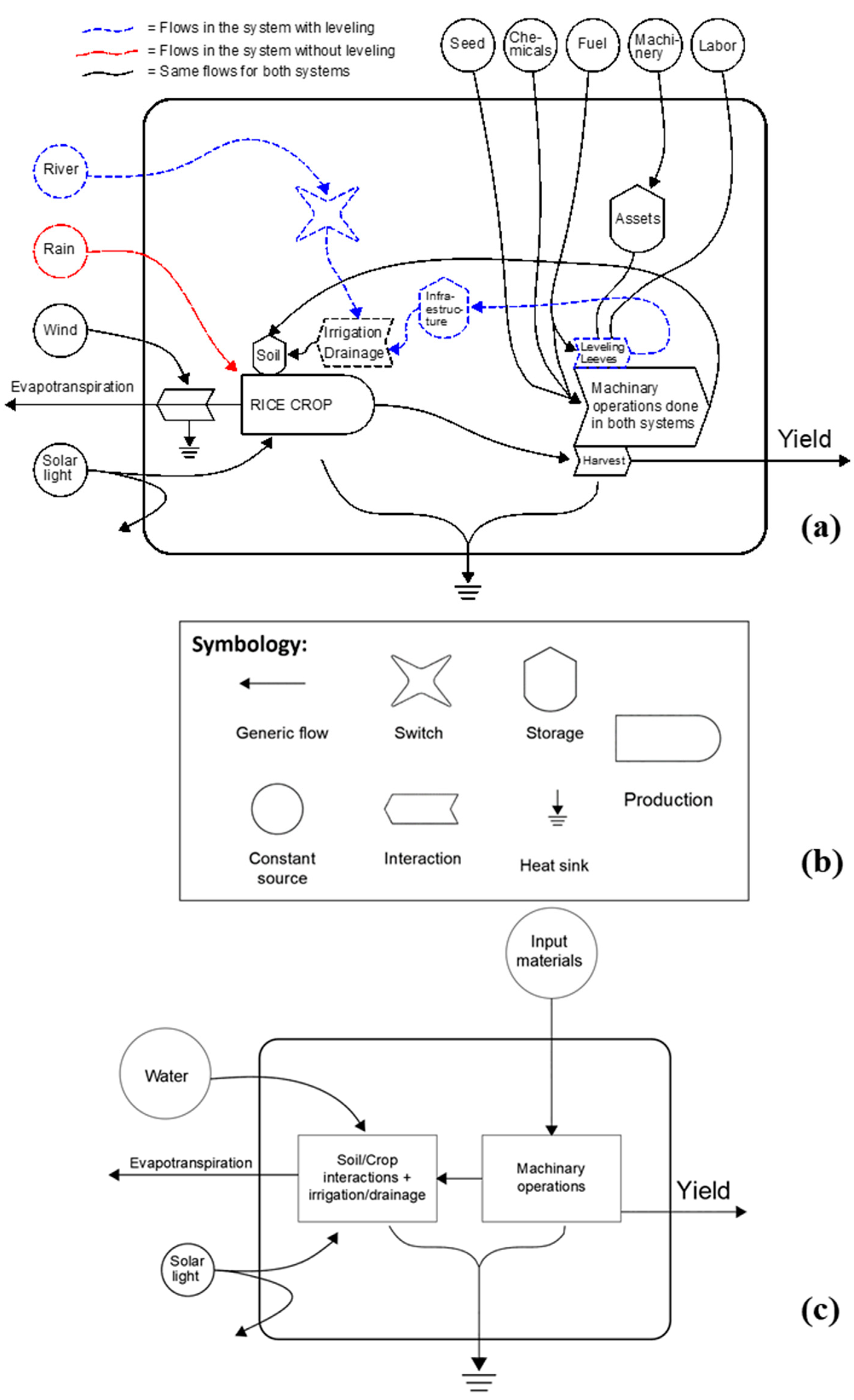
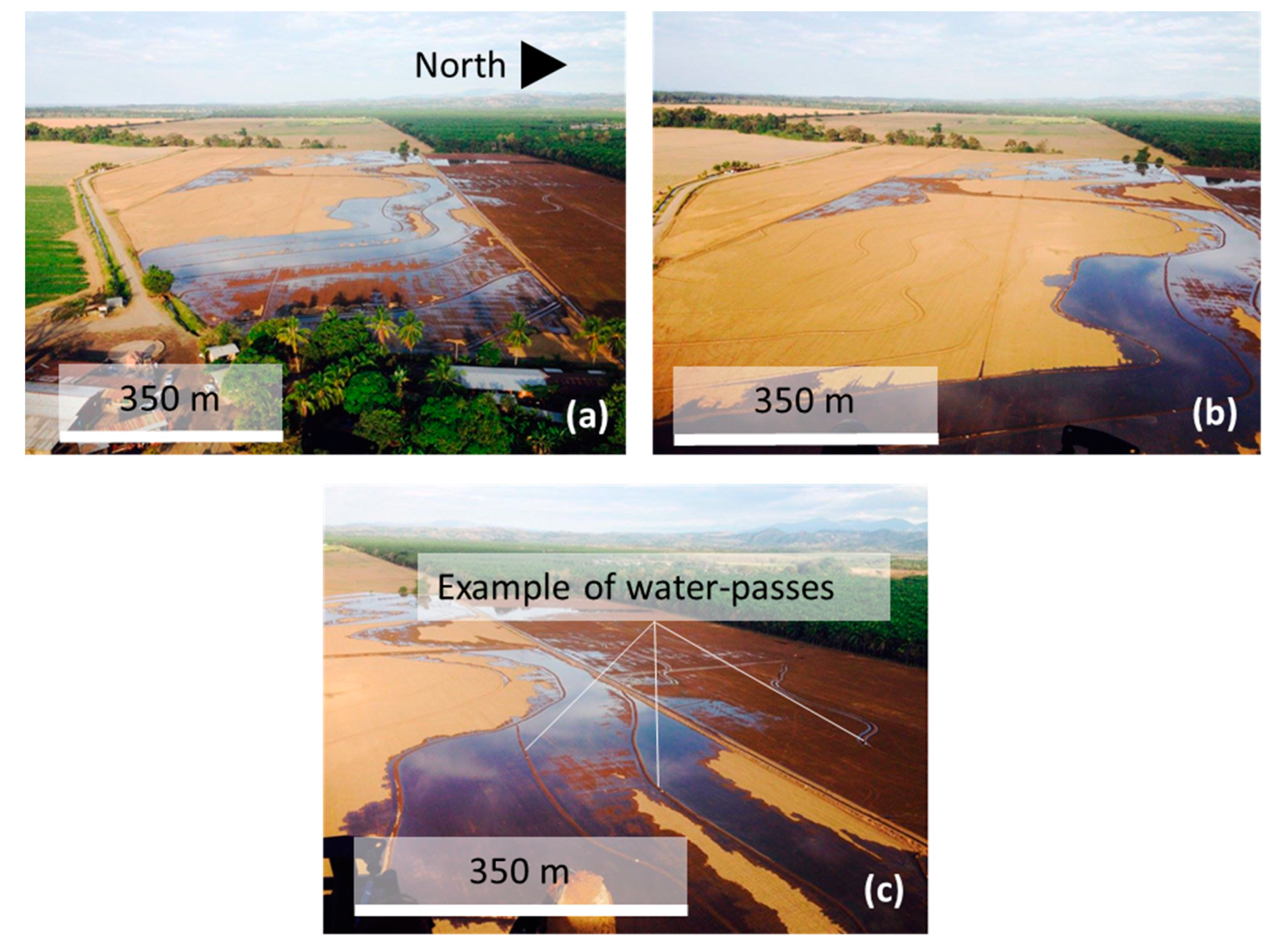
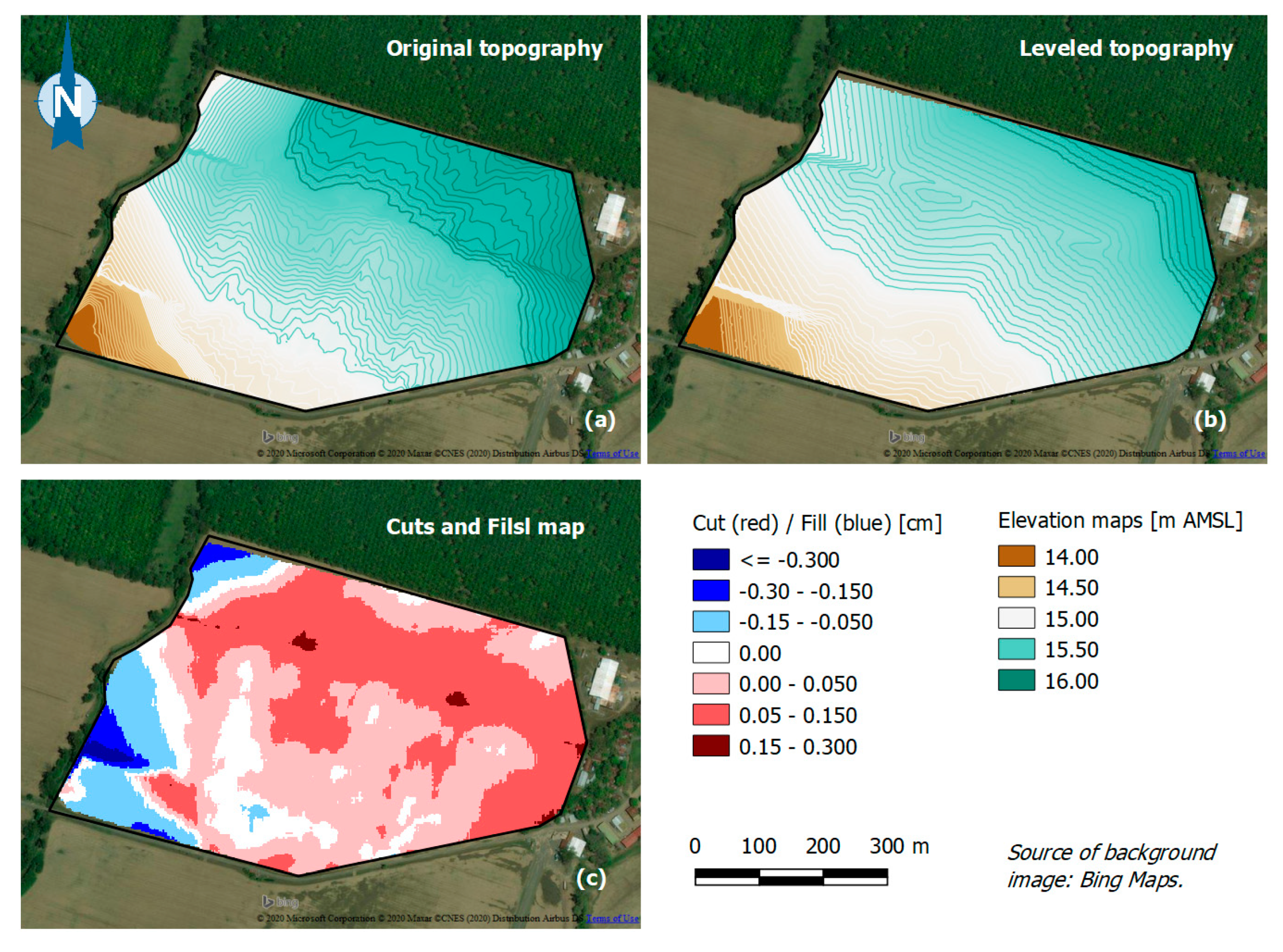

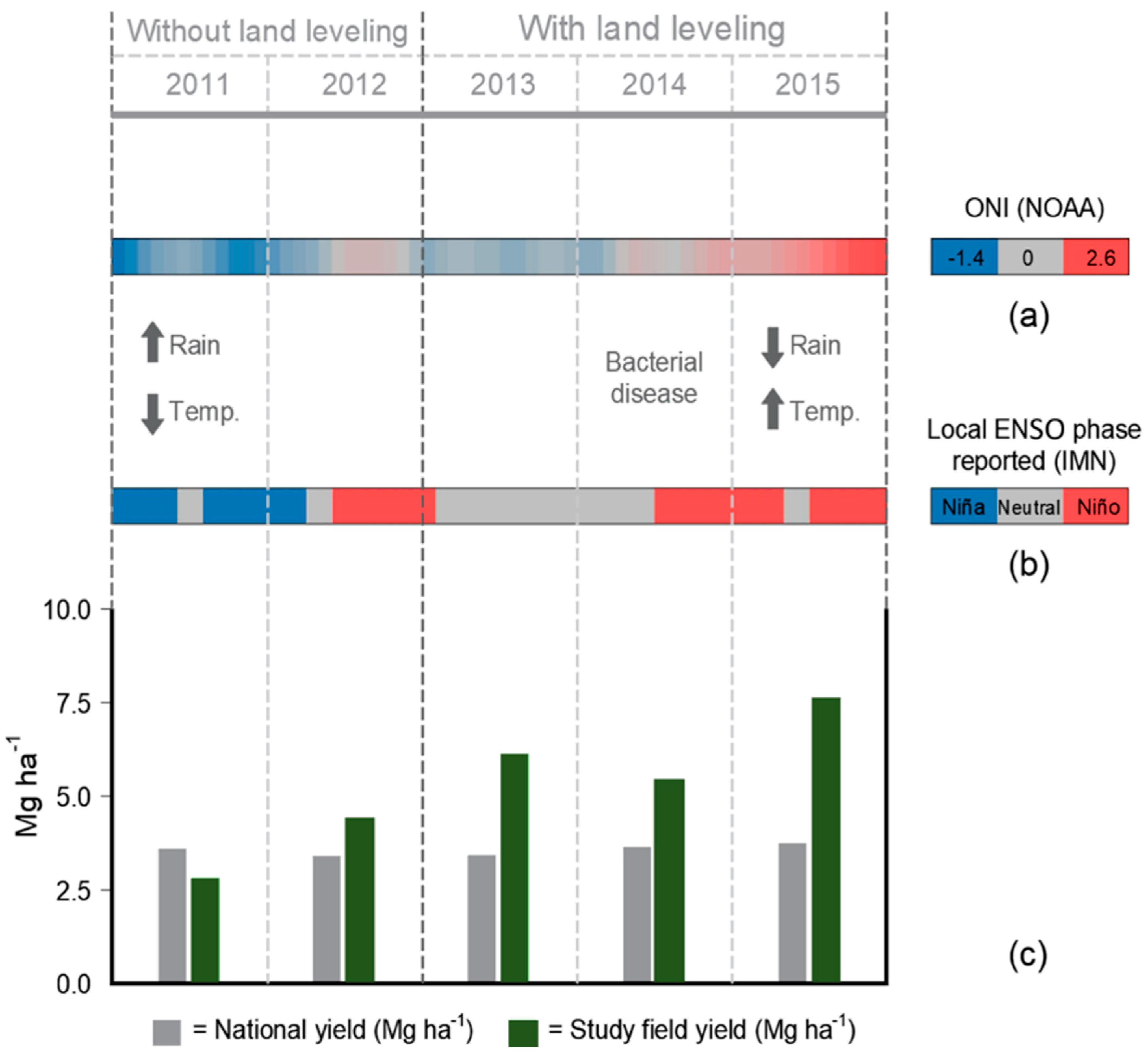
| Inputs | Applied (Kg ha−1) | Embodied Energy (MJ kg−1) | Input Energy (MJ ha−1) | |||
|---|---|---|---|---|---|---|
| Without Leveling | With Leveling | |||||
| Direct inputs | Seed | 115.00 | 14.60 [21] | 1679.00 | 1679.00 | |
| Insecticide | 28.50 | 50.00 [23] | 1422.50 | 1422.50 | ||
| Herbicide | 3.20 | 90.00 [23] | 283.50 | 283.50 | ||
| Fungicide | 12.10 | 50.00 [23] | 602.50 | 602.50 | ||
| Bactericide | 2.30 | 50.00 [23] | 112.50 | 112.50 | ||
| Fert. N | 43.80 | 73.00 [23] | 3199.60 | 3199.60 | ||
| Fert. P2O5 | 56.40 | 13.00 [23] | 733.30 | 733.30 | ||
| Fert. K2O | 64.90 | 9.00 [23] | 584.20 | 584.20 | ||
| Fert. Mg | 7.70 | 10.00 [23] | 76.60 | 76.60 | ||
| Subtotal | 8693.70 | 8693.70 | ||||
| Indirect inputs | Labor | Labor (h ha−1) | ||||
| Irrigation/drainage | 40.00 | 2.2 [14] | - | 88.00 | ||
| Weed control | 25.00 | 2.2 [14] | 55.00 | 55.00 | ||
| Manual fert. | 8.00 | 2.2 [14] | 17.60 | 17.60 | ||
| Other | 12.50 | 2.2 [14] | 27.50 | 27.50 | ||
| Subtotal | 100.1 | 188.1 | ||||
| Machinery | Fuel (L ha1−1) | |||||
| Blader roller | 8.50 | 56.30 [22] | 478.60 | 478.60 | ||
| Harrowing | 6.00 | 56.30 [22] | 337.80 | 337.80 | ||
| Leveling | 44.00 | 56.30 [22] | - | 2477.20 | ||
| Levee mark | 30.00 | 56.30 [22] | - | 1689.00 | ||
| Tune up surface | 40.00 | 56.30 [22] | 2252.00 | 2252.00 | ||
| Spraying | 1.20 | 56.30 [22] | 67.60 | 67.60 | ||
| Sowing | 15.00 | 56.30 [22] | 844.50 | 844.50 | ||
| Harvest | 20.00 | 56.30 [22] | 1126.00 | 1126.00 | ||
| Fertilization | 3.90 | 56.30 [22] | 219.80 | 219.80 | ||
| Subtotal | 5326.20 | 9492.40 | ||||
| Total input | 14,120.00 | 18,374.20 | ||||
| Outputs | Yield (Mg ha−1) | Embodied Energy (MJ Mg−1) | Input Energy (MJ ha−1) | |||
| Without Leveling | With Leveling | |||||
| Years | 2011 | 2.80 | 14,600.00 [21] | 40,296.00 | ||
| 2012 | 4.42 | 14,600.00 [21] | 64,532.00 | |||
| 2013 | 6.09 | 14,600.00 [21] | 88,914.00 | |||
| 2014 | 5.40 | 14,600.00 [21] | 78,840.00 | |||
| 2015 | 7.50 | 14,600.00 [21] | 109,500.00 | |||
| Total output | 104,828.00 | 277,254.00 | ||||
| Status | Year | Index | ||
|---|---|---|---|---|
| EROI | EP (kg MJ−1) | EB (MJ ha−1) | ||
| Not leveled | 2011 | 2.85 | 0.19 | 26,192.00 |
| 2012 | 4.57 | 0.31 | 50,412.00 | |
| Leveled | 2013 | 4.84 | 0.33 | 70,580.00 |
| 2014 | 4.29 | 0.29 | 60,506.00 | |
| 2015 | 5.96 | 0.41 | 91,166.00 | |
| Year | Investment (USD) | Partial Gain | Total Gain (USD) | ||||||
|---|---|---|---|---|---|---|---|---|---|
| CP * | IT * | IMO * | IL * | Yield (Mg) | Price (USD Mg−1) | (USD ha−1) | |||
| Not leveled * | 2011 | 2100 | 2.76 | 580 | 1601 | −499 | |||
| 2012 | 2100 | 4.42 | 580 | 2564 | 464 | ||||
| Leveled ** | 2013 | 2100 | 60 | 230 | 140 | 6.09 | 580 | 3532 | 1002 |
| 2014 | 2100 | 60 | 230 | 140 | 5.40 | 580 | 3132 | 602 | |
| 2015 | 2100 | 60 | 230 | 140 | 7.50 | 580 | 4350 | 1820 | |
Publisher’s Note: MDPI stays neutral with regard to jurisdictional claims in published maps and institutional affiliations. |
© 2020 by the authors. Licensee MDPI, Basel, Switzerland. This article is an open access article distributed under the terms and conditions of the Creative Commons Attribution (CC BY) license (http://creativecommons.org/licenses/by/4.0/).
Share and Cite
Quirós-Vargas, J.; Romanelli, T.L.; Rascher, U.; Agüero, J. Sustainability Performance through Technology Adoption: A Case Study of Land Leveling in a Paddy Field. Agronomy 2020, 10, 1681. https://doi.org/10.3390/agronomy10111681
Quirós-Vargas J, Romanelli TL, Rascher U, Agüero J. Sustainability Performance through Technology Adoption: A Case Study of Land Leveling in a Paddy Field. Agronomy. 2020; 10(11):1681. https://doi.org/10.3390/agronomy10111681
Chicago/Turabian StyleQuirós-Vargas, Juan, Thiago Libório Romanelli, Uwe Rascher, and José Agüero. 2020. "Sustainability Performance through Technology Adoption: A Case Study of Land Leveling in a Paddy Field" Agronomy 10, no. 11: 1681. https://doi.org/10.3390/agronomy10111681
APA StyleQuirós-Vargas, J., Romanelli, T. L., Rascher, U., & Agüero, J. (2020). Sustainability Performance through Technology Adoption: A Case Study of Land Leveling in a Paddy Field. Agronomy, 10(11), 1681. https://doi.org/10.3390/agronomy10111681






